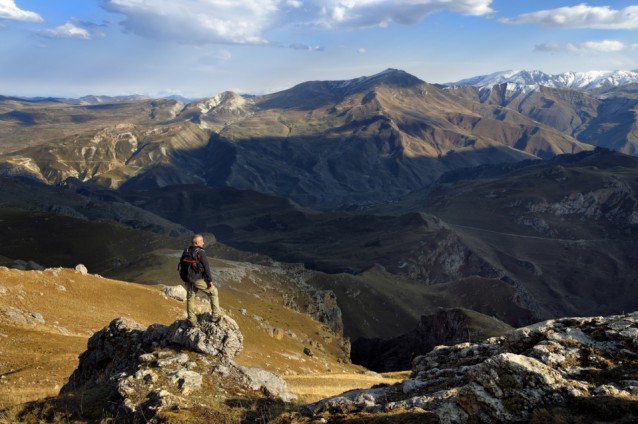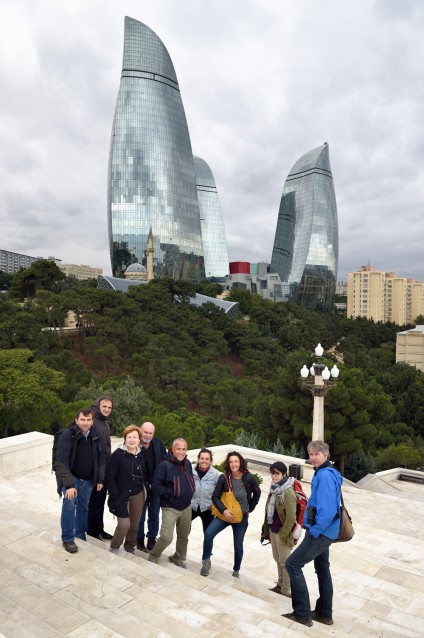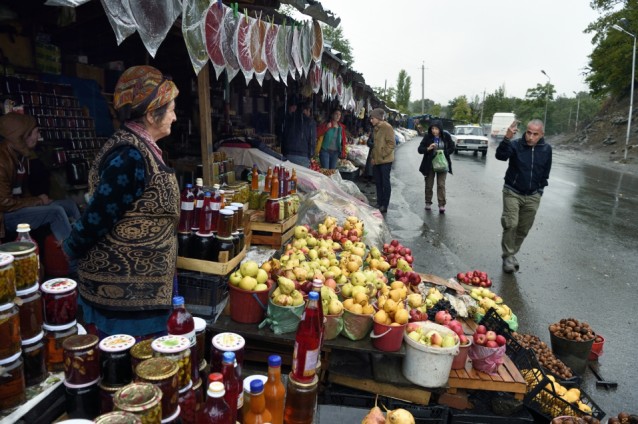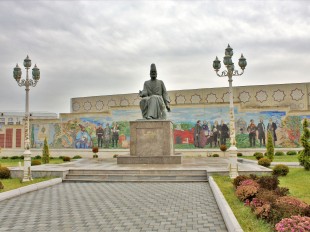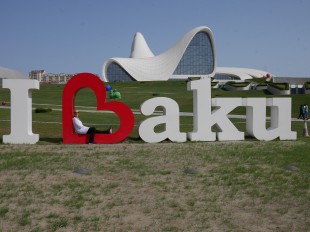Paris-based Nomade Aventure is a tour operator engaged in responsible tourism that achieved ATR certification in 2010. It has specialised in adventure programmes for almost 45 years, its clients travelling either by foot, bicycle, horse, kayak, boat or by local transportation. It provides unique itineraries off-the-beaten track, immersing its clients in local culture and always aiming to use local guides.
Issa Smatti is the Area Director for Central Asia, the Caucasus, the Himalayas, China and the Middle East at Nomade Aventure. He has recently been leading trips to the regions of Azerbaijan, focusing
on a natural environment that is virtually unknown to tourists, where the inherent Azerbaijani
tenets of multiculturalism, tolerance and hospitality are essential elements of the culture. Neil
Watson met him near his Parisian office to find out more.
VoA - What led you to decide to organise trekking trips to Azerbaijan?
IS - Many years ago, Nomade Aventure began organising trekking tours to the two other South Caucasus countries, which have proven very popular. I began to research the potential for organising such trips to Azerbaijan around a decade ago, but only finally managed to organise my first trip to the country during the past three years. However, the visa and flights were relatively cost-prohibitive even then. Thankfully, over the past few years, the Azerbaijani government has recognised the burgeoning importance of the tourism sector, and even designated 2011 as the Year of Tourism. I am pleased to note that several budget airlines are now serving Azerbaijan from France and the visa is now available via the ASAN Service upon arrival at the airport in Baku.
Your film Géorgie–Azerbaïdjan: rencontre avec les peuples du Caucase (Georgia–Azerbaijan: meeting with the peoples of the Caucasus) has been broadcast on several television channels. How has it been received?
The film has been broadcast on TV 5 Québec Canada, the 6ter channel operated by the M6 Group (France) and Voyage, a French channel operated by the Fox Networks Group. In my understanding, the film has been seen by around 4,000 viewers each time it was aired on the Voyage channel and 176,000 viewers on the 6ter channel, in addition to thousands of hits on Vimeo. The film certainly raised awareness of the activities offered by Nomade Aventure. I personally took two groups to Azerbaijan this year, and just escorted a party of French travel journalists and bloggers to the country.
What tours do you organise in Azerbaijan?
We currently offer five trips that either include or focus on Azerbaijan. Two cover both Iran and Azerbaijan, and another encompasses the three countries of the South Caucasus, lasting 18 days. Three programmes focus solely on Azerbaijan – one on trekking, another on culture, and the final is a snowshoes trekking tour. I am currently trying to push the trekking programme, which is the most rich and interesting for our regular clients, as our specialisation is in trekking, and this is also being added to the portfolio of our London subsidiary.
One of the unique elements of Nomade Aventure is that it is looking beyond Baku. Currently, the tourism sector in the country is focused on Baku, and the myriad hotels are full. The rest of the country effectively remains an unspoiled, well-kept secret. I would like to help bring some tourism revenues to the populations of the small villages. Although, it is essential to negate any impact on their lives, they must be able to derive some benefits from tourism. For example, the revenues can help with the provision of basic amenities in the regions. It is also the principle of Nomade Aventure that some part of the profit must be redistributed amongst the local population, and that is one of the many reasons why we favour the use of homestays and not hotels, and use local drivers.
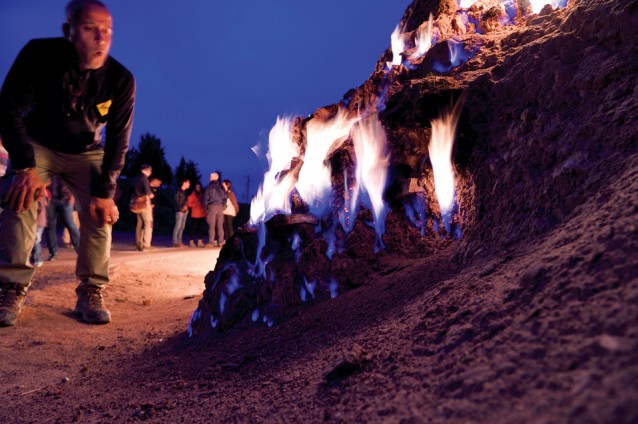 At Yanar dag, a small hill on the Absheron peninsula with a continuously burning flame. Photo: courtesy of Issa Smatti
At Yanar dag, a small hill on the Absheron peninsula with a continuously burning flame. Photo: courtesy of Issa Smatti
Azerbaijanis are renowned for their natural hospitality, and it is second nature for them. Although it is undeniable that such an approach is admirable, it is even better when some financial benefit is derived. The Azerbaijani regions boast a wonderful environment, the towns and villages are nestled in or overshadowed by the Caucasus Mountains, and their populations have a very specific culture. As the infrastructure of the country outside of Baku was not of good quality for a long time, the populations in all the regions have developed their own dialects, and some have their own languages, such as Tat, a southwestern Persian language spoken in such regions as Lahij and Khinaliq.
The approach of Nomade Aventure is apolitical, and serves to promote understanding and appreciation of the country. In my opinion, bringing journalists to the country on press trips with prearranged media support is the ideal approach. On our most recent trip, we brought reporters and bloggers representing some of the biggest French media outlets, including Grands Reportages, Le Monde and La Croix. Nomade Aventure is working very hard to promote Azerbaijan, and it is essential that travel journalists gain the best possible impression of Azerbaijan and what it has to offer.
How does the concept of homestays work?
We make contact with our potential homestay hosts via our contacts on the ground. Led by an intermediary, I meet the homestay hosts. I discuss the accommodation they have to offer and the hospitality they can provide. We have worked with many local people in this way over the past three years. Depending on the region, some hosts we use have previously accommodated travelling local people and foreign visitors on an ad hoc basis. However, we are now establishing something more regular by bringing our groups.
We aim not to affect the local populations, as the Nomade Aventure trekking groups are limited in size to 10–12 persons, with the smallest comprising four people. Regular visits of large groups have too much of an impact on the lives of the local inhabitants. We want to avoid them changing their mentality and behavioural patterns, as they must not feel they have become a tourist attraction. In many instances, these peoples continue to lead a very traditional existence, virtually unaffected by changes in politics and ideology. It is not the policy of Nomade Aventure to change their lives in return for business – we want to connect people.
If we can spark the interest of the local people, they will help visitors understand them, and usually the locals are interested in their visitors. Westerners and villagers can connect on a human level, and this can help perceived differences and problems to be overlooked. My objective each year is to lead four or five groups to Azerbaijan.
How many tourists have you taken to Azerbaijan?
In summer 2017, we took around 11 people to Azerbaijan, which is inadequate in my view. All were French and middle-aged, having come to us in search of a trip that differs from that which they have previously experienced. In our experience, younger people prefer to explore places by themselves. In comparison with other options, our trips tend to be slightly expensive, although we do provide a fixed packaged price for the entire excursion, including accommodation, food, transportation and guides.
Trekkers need to have a reasonably active lifestyle and be able to comfortably walk offroad for between one and two hours. Ideally, they should be experienced, and we urge them to take out insurance.
What feedback have you received from the tourists you take to Azerbaijan?
The travellers have always come away with a very positive attitude towards the country. In order to ensure the language barrier is overcome, the local guides participate in the entire trip. They sleep in the same hotel as the tourists, and travel with the group every day. They are the cultural and linguistic bridge for the travellers. The guides are found via local travel agencies. We aim to organise responsible tourism, never sending guides from France, as we prefer to give work to local people. We hope the locals will be more receptive to tourists in the future.
The Azerbaijani government is striving to increase tourist inflows. How does the work of Nomade Aventure fit with this strategy?
Overall, I support the strategy of the Azerbaijani government regarding tourism development. However, it is important that this is not Baku-centric and that tourism across the country is promoted. It is also essential that those working in the tourist industry have a specialised background. For example, those involved in organising trekking holidays must know about sourcing accommodation and the elements of Azerbaijani heritage that will be interesting to travellers.
Unfortunately, until recently, the general Azerbaijani understanding of tourism related to four- and five-star accommodation and the highest possible westernised standards. However, such travellers do not substantially invest in the local economy. The hotel revenues are not retained in the country, as everything is paid to the foreign operators, as are profits from bars and restaurants in the hotels. The Azerbaijani government understands our small-scale, apolitical approach, but does not support it enough.
Why should tourists visit Azerbaijan at the moment?
Primarily, they should come to enjoy the rich cultural heritage, the beautiful mountains and nature of the Azerbaijani regions and experience the irrefutable hospitality of the local people. In an increasingly globalised world, it is very interesting for Westerners to experience regions of this kind. Our job is also to connect populations who would not normally have any connection with each other.
What was the general reaction of the French journalists who participated on the press trip?
Since the trip, I have received a great deal of good feedback and photos. The journalists and I spent several days in the mountains, which provided an excellent perspective on the country that could be included in their reports. Throughout, we strived to avoid eating in hotels, instead preferring to eat with local people in homestays or in local restaurants. This also enabled the journalists to taste the local wine, which also forms an important part of the local culture.
The trip ably demonstrated the diversity of Azerbaijan, including its various religions and ethnicities, the realities of which are promoted by the Azerbaijani government. The journalists also asked if they could return and undertake an extensive trek in the country, thereby demonstrating that they were interested and enthused by what they saw.
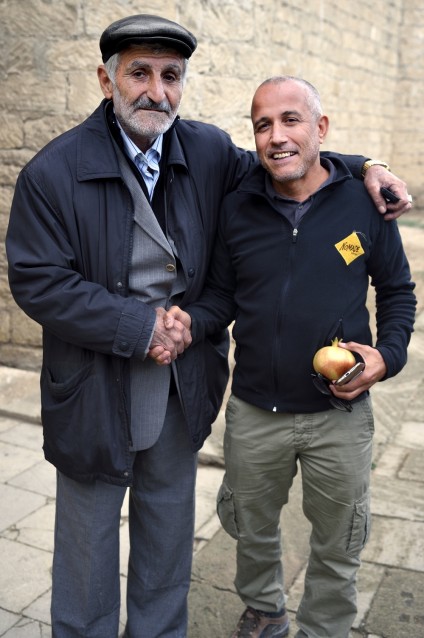 With local man, Vidadi, who looks after the 14th-century fortress in Mardakan. Photo: courtesy of Issa Smatti
With local man, Vidadi, who looks after the 14th-century fortress in Mardakan. Photo: courtesy of Issa Smatti
|
|
How do you regard Azerbaijan’s future development as a tourist destination?
The Azerbaijani Ministry of Culture and Tourism must promote all forms of tourism to the outside world. Nomade Aventure has now been promoting Azerbaijan for three years, and needs to undertake two or three press trips, make more films and to communicate about Azerbaijan via its newsletters to over 100,000 people at any one time. I also need to organise briefings about Azerbaijani holidays across France. Subject to receiving governmental support, I would like to produce films focusing on each of the big cities, such as Baku, Sheki and Ganja. These would emphasise the nature of Azerbaijani multiculturalism and the gastronomy.
I would like to organise trips by many groups with varied interests to Azerbaijan and to finally achieve my mission of developing this country into a tourist destination, as has been the case with the two other countries of the South Caucasus and Mongolia, for example. My objective is to bring a minimum of 10 groups per year, whether for culture, hiking or other activities, such as snowshoes trekking, skiing holidays in Shahdag, which has snow as early as November, kayaking, and horseriding, as the country is an ancient centre of equestrianism, particularly regarding the Karabakh horse breed.
There is great potential for the development of many forms of tourism in Azerbaijan. All that is required is governmental support at all levels and the desire to attract international tourists of every taste from all levels of society.
About the author: Neil Watson began working professionally as a journalist in 1995, became editor of his first magazine in 2000 and is a regular contributor to Visions.
